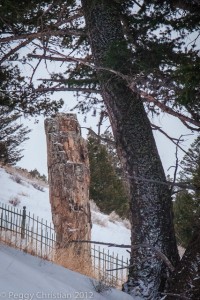
live tree turned to rock…
rain leeched minerals
feed new tree
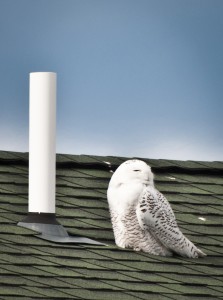 Spring is here. Last day of skiing–a season that started with a fizzle (lack of snow), ended with a drizzle (a downpour that washed out what little enthusiasm anyone had left for hitting the slopes). The trees are budding out and the buttercups are blooming in the backwoods.
Spring is here. Last day of skiing–a season that started with a fizzle (lack of snow), ended with a drizzle (a downpour that washed out what little enthusiasm anyone had left for hitting the slopes). The trees are budding out and the buttercups are blooming in the backwoods.
The irruption of snowy owls, who showed up last January in Polson for the first time in living memory, have headed back up to the Arctic. They caused quite a sensation while they were here though, with people carrying 3 foot camera lenses and giant spotting scopes invading the hilltop subdivision where the owls had taken up residence. Organized tours of bird enthusiasts came from as far away as Texas to gawk at the beautiful white owls sitting on asphalt shingled roofs.
I was one of the pilgrims who went to see the owls–and take the requisite pictures with my inadequate lens. But, unlike so many other birdwatchers, I came away feeling a little deflated. I have a friend who has spent years hiking and exploring in Alaska, always in hopes of seeing a snowy owl in the wild, with no success. And then he had to do nothing more than drive an hour north to Flathead Lake, look for the knot of cars and people on the water tower hill, and there they were. He didn’t even have to get out of his car.
I can understand my friend’s disappointment. I felt it too, though I hadn’t hiked hundreds of miles to see a snowy owl. Something was missing and it wasn’t just the incongruity of seeing those wild birds roosting near the white vent pipes in the subdivision. It had something to do with the thrill of discovery. The sense of wonder is muted when you don’t find something on your own, whether it’s a “wildlife viewing opportunity” like this or on a guided tour, nature show or in a zoo. It becomes somehow a second hand experience.
Discovering a bird in the wild, or maybe a snow leopard in the Himalayas as in Peter Mathiason’s book The Snow Leopard, is not about checking it off your life list or getting the picture. It’s about what you discover in yourself in the process. It’s about the search, and the feeling of awe when you make that discovery. To me, it’s like the difference between a flash of insight and connection when you’re writing and sitting down with a book, reading someone else’s wisdom.
Maybe that’s the reason a week later when visiting Yellowstone, I didn’t mind not making it out to the Lamar Valley to see the wolves. Mammoth was abuzz with the pack of wolves who were feeding on a bison carcass near the road and people were showing off their pictures. But I was afraid the experience would be like the snowy owls. Instead, I contented myself with savoring the sight of a merganser swallowing a giant (5″) silver fish whole. No one’s totem animal I know, but the sighting was mine and a thrill.
P.S. There was an article today in the Missoulian (Thursday, April 19) that said there are now a couple of different apps for your phone that will report wildlife sightings in Yellowstone. The only saving grace for such insanity is that cell phone coverage is spotty in Yellowstone.
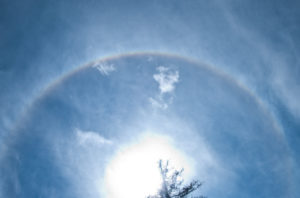
While we wait for the flowers to come up, we can turn our eyes to the sky and indulge in another game of identification, Cloudspotting. This example is a 22 degree halo seen in the Cirrostratus clouds. This type of cloud is composed of a delicate layer of ice crystals and the halo is made by sunlight refracted by the crystals. Cloudspotting can turn the most mundane trips around town into a real naturalist’s adventure and there are several books that can heighten the experience.
First is The Cloudspotter’s Guide: The Science, History, and Culture of Clouds by Gavin Prector-Prinney. He gives detailed descriptions of the different kinds of clouds and their subspecies, like the wispy Cirrus clouds or “mare’s tails” outside my window just now. It also includes interesting tidbits like the history of the meteorologists in Bergen Norway who first worked out the complex science of the development of rain clouds, and the Chinese scientist Zhonghas Shou who is using the appearance of certain cloud types as a short term earthquake predictor.
If you want to share this experience with kids, Tomie De Paola’s The Cloud Book is a great introduction. He describes the basic cloud types, mixing elementary scientific information with the mythology of clouds and the popular sayings that have been used for centuries to predict weather. “When the fog goes up the mountain hoppin’, then the rain comes down the mountain drippin’.”
To take your cloud spotting to the next level The Cloud Collector’s Handbook, also by Pretor-Pinney, gives you a field guide and a “birding list” in one. Each type of cloud you find and record is worth points. Living in Missoula it is easy to get 15 points for the Stratus that lay low in the valley on inversion days, and you can pick up another 5 points for getting above the clouds and seeing their undulating upper surface.
Very young children can join in the fun as well with Eric Carle’s Little Cloud, a great book for encouraging the age old game of spotting different shapes in the clouds.
Finally, check out www.clouds365.com where you can share your finds with this online cloud appreciation community.
This book review will appear in the Montana Naturalist Magazine, spring issue, put out by the Montana Natural History Center
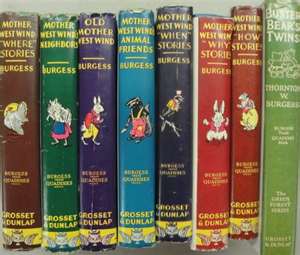
We begin at the derelict packrat cabin. Slowly we plod up the overgrown road. Our snowshoes tangle in the branches of the downed tree as we struggle to get over or under it. There are 15 of us. The oldest is 85 and grew up on a ranch before plumbing and electricity. The sturdiest is 78 and was raised on a Mennonite farm. She knows the ways of self-sufficiency. She is followed by her husband. He has spent 37 summers in a lookout tower watching the top of this mountain for a spark of fire. I am the youngest, struggling to learn what these fellow hikers have known all their lives.
intrepid guides
wear a deep path through new snow
I follow their tracks
On the saddle the trees open out into a meadow. A chipmunk alerts the woods to our presence. A raven cackles overhead. The transmission lines which cut through these wild woods whines with power for towns all along the Montana Highline. To the east the Rattlesnake Wilderness flows around the base of Stewart Peak. To the southwest the city of Missoula creeps up the sides of the hills.
divide
between two worlds
we catch our breath
We mill around the clearing until we find three sets of tracks slicing across the snowfield. Four large rounded toes. A three lobed heel pad. They are as large as the palm of my hand, with a leading toe that lines up with my middle finger. No nail marks. The print of a tail drag.
wild eyes peer
flash of tawny fur amid the trees
a squirrel or…
A storm cloud shadows the meadow. We cross over to the opposite slope and begin our decent. From here there is no straight path down to the old homestead. We wander through the tangle of mountain ash and serviceberry bushes. We duck under canopies of Douglas Fir and step over deadfall.
cocked heads
snowshoe hare tracks
in unblemished snow
At the bottom of the draw we go to inspect the ruins. Hopes and dreams stacked in peeled logs that cave in from the center. Through the window frame an aspen tree grows in the middle of the barn. The decaying timbers, cut in 1911 to shelter the inhabitants from the elements now rot in the rain and snow, feeding the undergrowth that is reclaiming the homesite.
single broken wall
thin divide between
the wild outside and in.
This piece is in the form of a haibun. Haibun tells a story, mixing a short prose piece with a haiku.
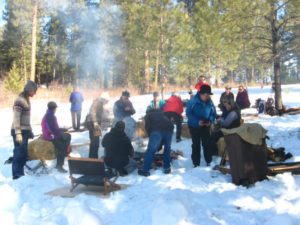
Last week I hosted the Tuesday Hikers annual winter cookout at the homestead. I felt honored to carry on the tradition Lois began many years ago. And I felt privileged to share this special place with my wildland family. Despite growing up in the mountains cooking over fires, there is always something I can learn from my “elders” in the group. Like cooking a hardboiled egg in a paper cup in the fire. Carol taught me this trick–fill a dixie cup with water, drop in the egg and set it on the coals. Incredibly it doesn’t ignite. Only the lip of the cup will catch fire and burn to the water line. The egg will boil in the water and after 10 minutes or so you have a perfectly cooked hardboiled egg.
It was a stunningly clear day and from the meadow where Ted and I had set up the fire pit you could see the receding mountain ridges to the west. Gene, who has been the fire lookout at Blue Mountain for 37 seasons has an aerial map in his head and he was able to instantly identify Petty Peak and the Cabinet Mountains shining white in the far distance. I envy this mental relief map he has of the region. I can look at a topo map and get my bearings. I can download satellite pictures of the area and have an overview of my place in the world. But these are only snapshots. Gene has a dynamic and deep knowledge of the landscape that comes from years of watching its constant change. He has seen storms come in across the peaks and where the clouds tend to lay low in the valleys. He knows where rain falls the heaviest or misses the lowland in the rain shadows. He has seen the changing face of the mountain peaks as the snowline recedes, the cloud shadows pass over, or the aplenglow hits in the late evening. He knows these ranges in a way few of us ever will. I hope as the years pass I will come to know this small slice of the Lolo Range through the same attentive and intimate acquaintance.